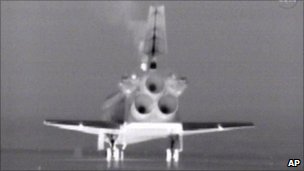 Space shuttle Atlantis has landed back on Earth, bringing to a close America's 30-year orbiter programme.
Space shuttle Atlantis has landed back on Earth, bringing to a close America's 30-year orbiter programme.
The vehicle swept into the Kennedy Space Center in Florida, its wheels touching the runway just before local sunrise (0556 EDT; 0956 GMT; 1056 BST).
Retirement of Nasa's iconic shuttle fleet was ordered by the US government, in part due to the high cost of maintaining the ships.
The decision leaves the country with no means of putting astronauts in orbit.
The US space agency's intention is to invite the private sector to provide it with space transport services, and a number of commercial ventures already have crew ships in development.
These are unlikely to be ready to fly for at least three or four years, however.
In the interim, Nasa will rely on the Russians to ferry its people to and from the International Space Station.
Despite the dark skies over the Space Coast, large crowds came out to try to glimpse Atlantis as it made its historic return from orbit. Even in Texas, where mission control is sited, people mingled outside the gates of the Johnson Space Center.
The de-orbit track brought Atlantis across central Florida and the Titusville-Mims area before a hard bank to the left put the vehicle on a line to Runway 15 at Kennedy.
Touch-down marks a moment of high emotion for the local region - not least because it will trigger a big lay-off of contractor staff. Some 3,000 people involved in shuttle operations will lose their jobs within days.
The orbiter programme itself does not officially end for a month, but even then it is likely to take a couple of years to close all activities, such as the archiving of decades of shuttle engineering data.
For Atlantis, its retirement will be spent as a static display at the Kennedy visitor complex.
The Discovery and Endeavour shuttles, which made their final flights earlier this year, will go to the Air and Space Museum's Udvar-Hazy Center in Virginia and the California Science Center in Los Angeles, respectively.
Nasa itself hopes to invest money saved from shuttle operations in a new spaceship and rocket that can take humans beyond the ISS to destinations such as the Moon, asteroids and Mars.
The conical ship, known as Orion, has already been defined and is in an advanced stage of development. The rocket, on the other hand, is still an unknown quantity.
The US Congress has told the agency what its minimum capabilities should be. However, the agency is currently struggling to put those specifications into a concept it says can be built to the timeline and budget specified by the politicians.
It promises to detail the rocket's baseline design before the summer is out.



